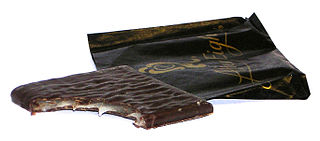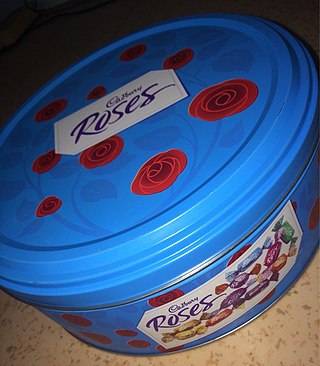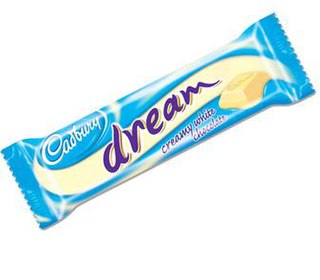
Cadbury, formerly Cadbury's and Cadbury Schweppes, is a British multinational confectionery company owned by Mondelez International since 2010. It is the second-largest confectionery brand in the world, after Mars. Cadbury is internationally headquartered in Greater London, and operates in more than 50 countries worldwide. It is known for its Dairy Milk chocolate, the Creme Egg and Roses selection box, and many other confectionery products. One of the best-known British brands, in 2013 The Daily Telegraph named Cadbury among Britain's most successful exports.

Caramilk is a brand name used for two distinct chocolate bar products made by Cadbury. Both were introduced in 1968. The Canadian version of Caramilk is a milk chocolate bar filled with caramel. In Australia the Caramilk brand is used for a caramelised white chocolate bar.

Cadbury Dairy Milk is a British brand of milk chocolate manufactured by Cadbury. It was introduced in the United Kingdom in June 1905 and now consists of a number of products. Every product in the Dairy Milk line is made with exclusively milk chocolate. In 1928, Cadbury's introduced the "glass and a half" slogan to accompany the Dairy Milk chocolate bar, to advertise the bar's higher milk content.

Terry's Chocolate Orange is a chocolate product with orange flavour created by Terry's in 1932 at Terry's Chocolate Works in York, England. The brand has changed ownership several times, and production was moved to Poland in 2005. Since 2018, the Terry's Chocolate Orange has been produced in Strasbourg, France, by Carambar.
Wispa is a brand of chocolate bar manufactured by British chocolate company Cadbury. Using aerated chocolate, the bar was launched in 1981 as a trial version in North East England, and with its success it was introduced nationally in 1983. It was seen as a competitor to Rowntree's Aero . In 2003, as part of a relaunch of the Cadbury Dairy Milk brand, the Wispa brand was discontinued and the product relaunched as "Dairy Milk Bubbly". As part of the relaunch, the product was reshaped as a standard moulded bar instead of a whole-bar count-line.

Aero is an aerated chocolate bar manufactured by the Vevey-based company Nestlé. Originally produced by Rowntree's, Aero bars were introduced in 1935 to the North of England as the "new chocolate". By the end of that year, it had proved sufficiently popular with consumers that sales were extended throughout the United Kingdom.

Hershey's Kisses are chocolates first produced by the Hershey Company in 1907. The bite-sized pieces of chocolate have a distinctive conical shape, sometimes described as flat-bottomed teardrops. Hershey's Kisses chocolates are wrapped in squares of lightweight aluminum foil. A narrow strip of paper, called a plume, protrudes from the top of each Hershey's Kiss wrapper. Originally designed as a flag for the "Hershey's" brand, the printed paper plumes were added to the Kisses product wrapper in 1921 to distinguish the Hershey's Kiss from its competitors who were offering similar products.

Reese's Peanut Butter Cups are an American candy by the Hershey Company consisting of a peanut butter filling encased in chocolate. They were created on November 15, 1928, by H. B. Reese, a former dairy farmer and shipping foreman for Milton S. Hershey. Reese was let go from his job with Hershey when the Round Barn which he managed was shut down for cost-saving measures. He subsequently decided to start his own candy business. Reese's are a top-selling candy brand worldwide, with $3.1 billion in annual sales.

After Eight Mint Chocolate Thins, often referred to as simply After Eights, are a brand of mint chocolate covered sugar confectionery. They were created by Rowntree Company Limited in the UK in 1962 and have been manufactured by Nestlé since its acquisition of Rowntree in 1988.

Milka is a Swiss brand of chocolate confectionery. Originally made in Switzerland in 1901 by Suchard, it has been produced in Lörrach, Germany, from 1901. Since 2012 it has been owned by US-based company Mondelez International, when it started following the steps of its predecessor Kraft Foods Inc., which had taken over the brand in 1990. It is sold in bars and a number of novelty shapes for Easter and Christmas. Products with the Milka brand also include chocolate-covered cookies and biscuits.

Maltesers are a British confectionery product manufactured by Mars Inc. First sold in the UK in 1937, they were originally aimed at women. They have since been sold in Europe, Australia, New Zealand, Canada, United States and Middle East. The slogan is "The lighter way to enjoy chocolate".
Heroes is a brand of boxed/tinned confectionery of a miniature collection of chocolate bars currently manufactured by Cadbury. Introduced in September 1999, they were a response to rival Mars' Celebrations and contain miniature versions of various Cadbury chocolate bars. Heroes are most popular around holidays, such as Christmas, Halloween and Easter.

The Hershey's Milk Chocolate Bar is a flagship chocolate bar manufactured by The Hershey Company. Hershey refers to it as "The Great American Chocolate Bar". The Hershey Milk Chocolate Bar was first sold in 1900.

Cadbury Roses is a brand of chocolates made by Cadbury. Introduced in the UK in 1938, they were named after the English packaging equipment company "Rose Brothers" based in Gainsborough, Lincolnshire, that manufactured and supplied the machines that wrapped the chocolates.

Hershey's Cookies 'n' Creme is a candy bar manufactured by The Hershey Company and first introduced in 1994.

Cadbury Mini Eggs are a milk chocolate product created and produced by Cadbury. Introduced in 1967, the egg is solid milk chocolate encased in a thin coating of hard candy "shell", molded to resemble a miniature egg.
The Cadbury Creme Egg Twisted was a chocolate bar produced by Cadbury UK in the United Kingdom. It was a milk chocolate bar with a filling of Cadbury Creme Egg fondant. Introduced in 2008, it was a result of Cadbury researching that customers wanted the Creme Egg to be available all year, mainly for the fondant centre rather than the egg shape. Previously, the fondant Creme Egg center was available as a filling in the Cadbury Dairy Milk line, but that has since then been phased out with the Creme Egg Twisted replacing it. Currently, only the Cadbury Heroes mini variation is available in the UK.

Dream is a brand of white chocolate by Cadbury. It is no longer manufactured under the former name in the UK, though it is still manufactured in this form in Australia, New Zealand, and South Africa. It is similar to a Milkybar, which is made by Nestlé. Some of the difference between it and Milkybar is that "Dream" uses real cocoa butter, is slimmer than the Milkybar, and the Milkybar uses puffed rice. Cadbury also released 'Cadbury White Giant Buttons' and plan to release 'Freddo White Treasures'.




















